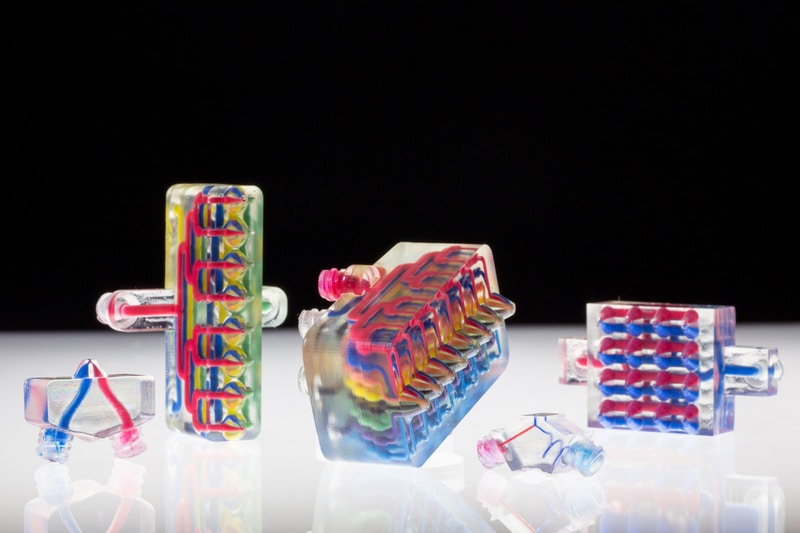Researchers at Harvard University have developed a new method of 3D printing. Termed multimaterial multinozzle 3D printing, or MM3D, the method seeks to help define the emerging paradigm of voxel by voxel fabrication.
In this paradigm, 3D printed parts are composed of minute building blocks. Each of these blocks has a different material composition, and are precisely arranged to tune part performance, i.e. softer materials for flexibility, harder materials for pressure resistance. A type of “true” 3D printing, the method is being explored in order to produce functional objects within a single process, rather than relying on assembly of different parts.
“This method enables the rapid design and fabrication of voxelated matter, which is an emerging paradigm in our field,” describes corresponding author Professor Jennifer A. Lewis. Indicating the impact of MM3D, Professor Lewis adds:
“Using our broad palette of functional, structural, and biological inks, disparate materials can now be seamlessly integrated into 3D-printed objects on-demand.”

One nozzle, 8 materials, 50 exchanges per second
The core concept of MM3D is a printhead containing multiple channels for the delivery of up to eight different materials through one single nozzle. Each of these nozzles can switch between materials up to 50 times per second. To prevent any unwanted mixing of materials, the channels contain Y-shaped junctions that prevent material backflow, preserving the quality and detail of the printed object.
By switching materials within the same printhead, and adding further nozzles to deposit voxels simultaneously, MM3D dramatically reduces print times. Mark Skylar-Scott, co-first author of a paper detailing the method explains, “When printing an object using a conventional extrusion-based 3D printer, the time required to print it scales cubically with the length of the object, because the printing nozzle has to move in three dimensions rather than just one.
“MM3D’s combination of multinozzle arrays with the ability to switch between multiple inks rapidly effectively eliminates the time lost to switching printheads and helps get the scaling law down from cubic to linear, so you can print multimaterial, periodic 3D objects much more quickly.”
As a demonstration of the technology, the team, all working within the Wyss Institute for Biologically Inspired Engineering and John A. Paulson School of Engineering and Applied Sciences (SEAS), 3D printed a moving soft robot. Designed with an origami-like architecture, and inner channels, the robot can be made to walk by compressing the channels with a vacuum. Moving at almost half an inch per second, this robot was capable of transporting objects up to nearing eight times its own weight.
Voxelated Soft Matter via Multimaterial, Multinozzle 3D Printing from Wyss Institute on Vimeo.
A myriad of material combinations
Voxel by voxel 3D printing is a method that is being commercially explored through Stratasys PolyJet technology as part of the GrabCAD Voxel software. In 2018, Neri Oxman and colleagues at MIT’s Mediated Matter Group filed a patent relating to a process of preparing files for voxel by voxel fabrication.
Combining their shared expertise, MIT’s Mediated Matter Group and a team from the Wyss Institute recently applied a pixel-by-pixel 3D printing approach to turn MRI and CT scan data into a detailed medical model.
With the MM3D technique, the Harvard team are experimenting with new materials, smaller nozzles, and larger nozzle arrays to expand the capabilities of the method. One particular area that warrants further exploration is the use of reactive materials. Co-first author Jochen Mueller comments, “Because MM3D printing can produce objects so quickly, one can use reactive materials whose properties change over time, such as epoxies, silicones, polyurethanes, or bio-inks.”
The paper detailing MM3D is titled “Voxelated soft matter via multimaterial multinozzle 3D printing” and is published in Nature. It is co-authored by Mark A. Skylar-Scott, Jochen Mueller, Claas W. Visser and Jennifer A. Lewis.
Subscribe to the free 3D Printing Industry newsletter for the latest research developments. You can also stay connected by following us on Twitter and liking us on Facebook.
Looking for a career in additive manufacturing? Visit 3D Printing Jobs for a selection of roles in the industry.
Featured image shows multimaterial multinozzle 3D printing (MM3D) from Harvard University. Photo via Wyss Institute at Harvard University


